
Note: I wrote this review for people who have thought about getting some self defense training, but don’t have a lot of time or money to invest in it, and are considering the MovNat Combatives course as a “best-bang-for-your-buck” option.
The question I want to answer with this MovNat Combatives review is: will this 2-day self-defense course actually help you prepare for violence? And is it the right course for you?
The short version of my review: I think this is a superb introductory course for preparing you mentally and physically for the realities of violence, and I know several lifelong martial artists and at least one pro MMA fighter (Carlos Condit) who agree.
So, let’s start with the good news: Most people rarely, if ever, encounter violence during their lifetimes.
The bad news: Most people who do are usually very ill-prepared for dealing with it.
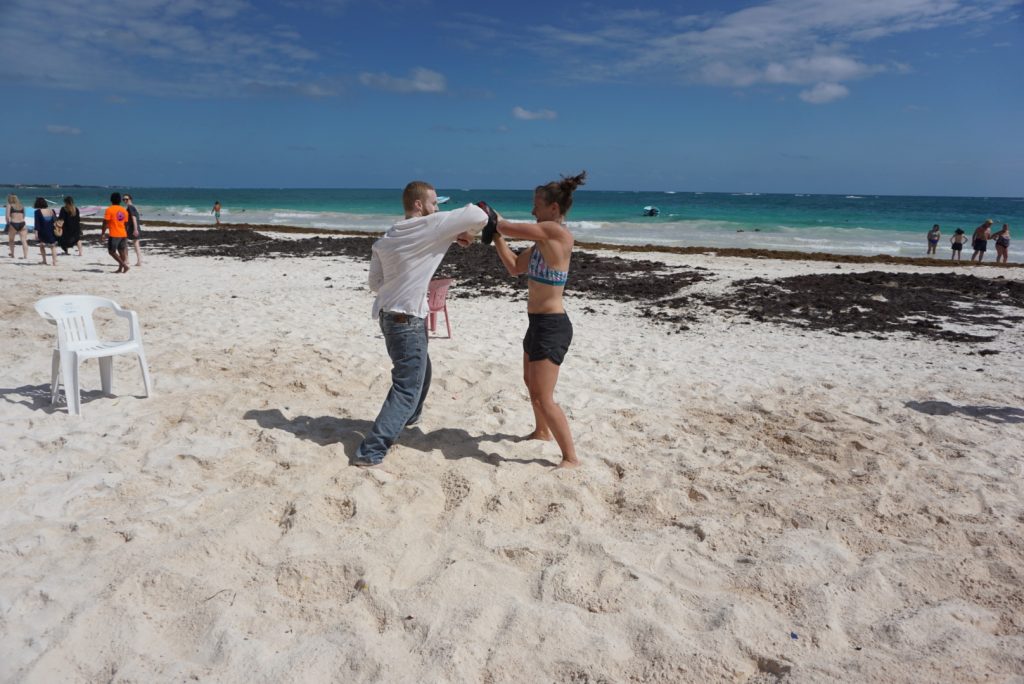
So, the question is: what do we do about it?
Well, you can either live in ignorance, hoping nothing bad ever happens to you. Or, you can take reasonable steps to prepare for the possibility of having to defend yourself. Does that mean you have to spend hours every week at the dojo? Not necessarily. While that may be a best-case scenario, most people don’t have that kind of time to devote to training for something that is unlikely to happen. But personally, I think it’s prudent to spend some time learning and especially practicing basic self defense skills and techniques…and not just the “moves,” which are actually not the most important aspect of self protection training (which was one of the very first things taught in this course).
I have always wanted to get some unarmed self defense training. I’ve taken some beginner classes and basic training courses (including a half day of striking and grappling instruction at a 5-day MovNat retreat I attended in 2009), but I’ve never been a martial artist, combat athlete, or anything like that. And although I’ve had a few close calls, I’ve never been in a fight as an adult. So, other than a lot of goofing off when I was a kid, including a few fights where nobody really got hurt, I’ve never experienced real violence…which is a good thing.
But I’ve always known this is a major gap in my training and overall preparedness. So, since I’ve been a long-time MovNatter and have never seen a negative review of this Combatives course, I decided to attend an event in Tulum, Mexico last winter.
Because what else would you rather do on the beach, right?
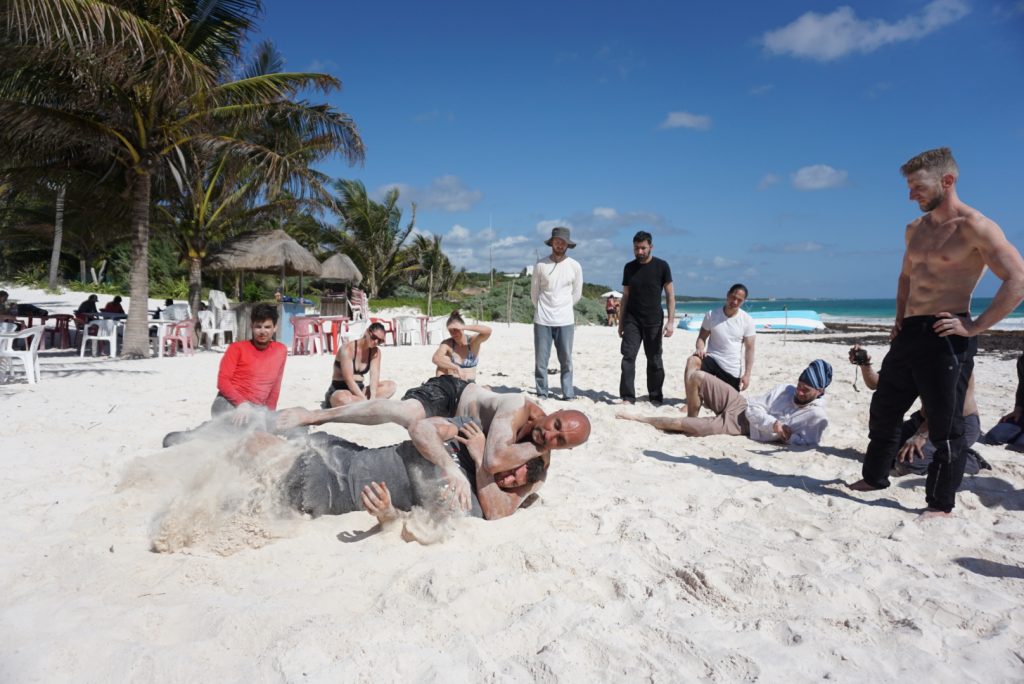
MovNat Combatives is a 2-day intensive workshop/certification taught by self defense expert, Vic Verdier, about how to deal with real violence – not sports, martial arts, or other organized fighting with rules and structure. It was about how to get home to your loved ones if you are ever targeted by the bad guys who mean to do you grave harm.
In my mind, the main benefit of a course like this – on top of the education itself – is to get a sense of what your true capability is in a violent encounter. Most people just don’t know what they would do if they were suddenly and unexpectedly attacked…panic, freeze, run, fight? So, a course like this is invaluable for getting a good dose of reality.
From what I can tell, our instructor, Vic, is the real deal. He has a very long list of credentials, including a career as a special forces instructor. He’s one of only four MovNat Master Instructors in the world. He’s also taken virtually every well-known self defense course available, which I suspect have all contributed to this one-of-a-kind course he created and teaches around the world.
Another “credential” Vic has is that once you get to know him, you realize he doesn’t want to hurt anyone. Even though Vic…
1) likes dressing in black,
2) could kill you five different ways using just his thumbs,
3) and could double as an assassin in a vintage film…
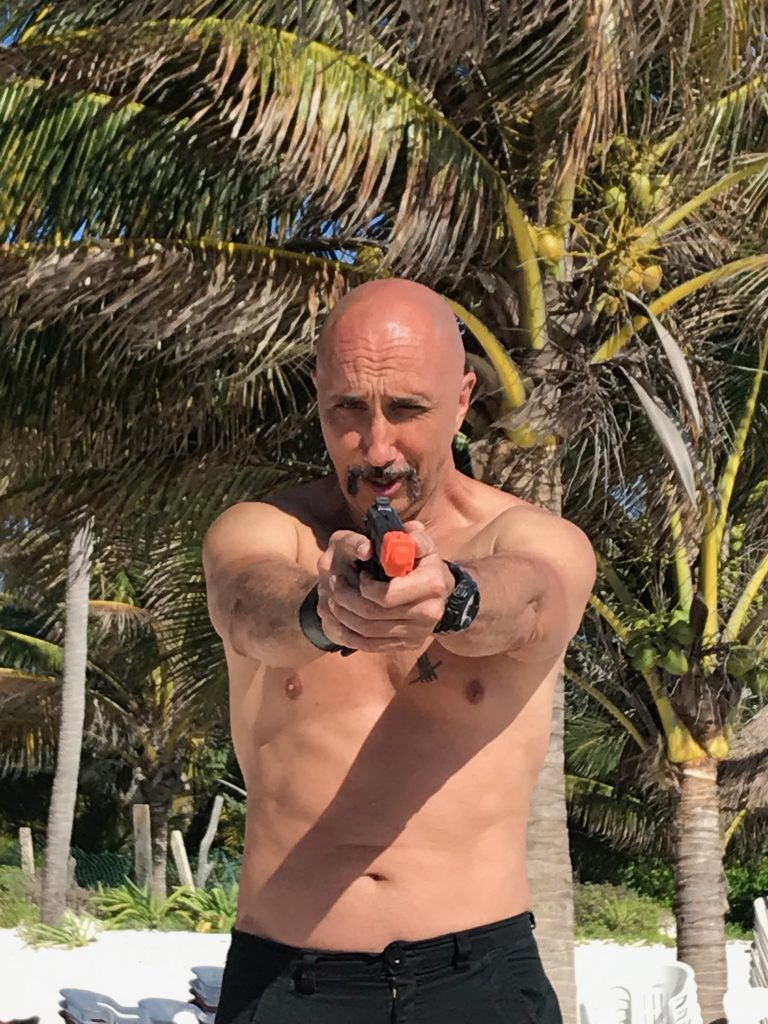
He is not a macho “tough guy” like many other supposed self defense experts tend to act. That has been a common theme among the most dangerous men I know. The more skilled at violence they are, the more humble, and nonchalant they seem to be.
So, what did we learn from Vic and each other at MovNat Combatives?
Let me tell you. These two days were like drinking water out of a fire hose!
We started the course by examining some of the ugly realities of violence, which included analysis of video footage of real violence. And not the kind you see in movies or sport MMA. But real people trying to kill each other on the streets (i.e. both social and asocial violence). Some found it difficult to watch, and there were even gasps heard among the group. But if you want to prepare for real violence, you need to understand how it actually works.
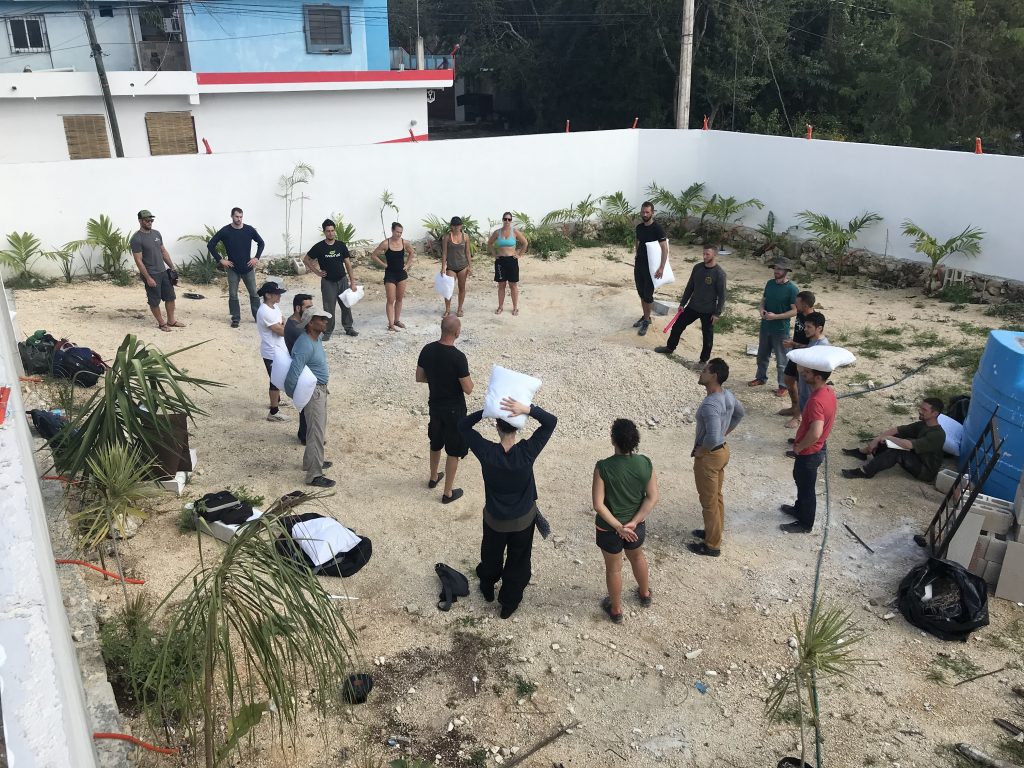
So, we learned about the principles of violence, and some general “best practices,” which were regularly referenced throughout the rest of the course. We learned several techniques to maintain your personal “bubble” when someone is getting uncomfortably close.
We learned to think like a criminal and how to deal with multiple aggressors. We learned that it’s always safer to avoid a fight, and running away is better than engaging an aggressor.
We learned visual and body language cues that usually precede an attack (e.g. a sucker punch). We also learned about the best targets for disabling an attacker (even canines), about natural tools and weapons (i.e. using your body), how to strike with your head/elbows/forearms/hands/knees/feet, ground survival, and what to do after the fight.
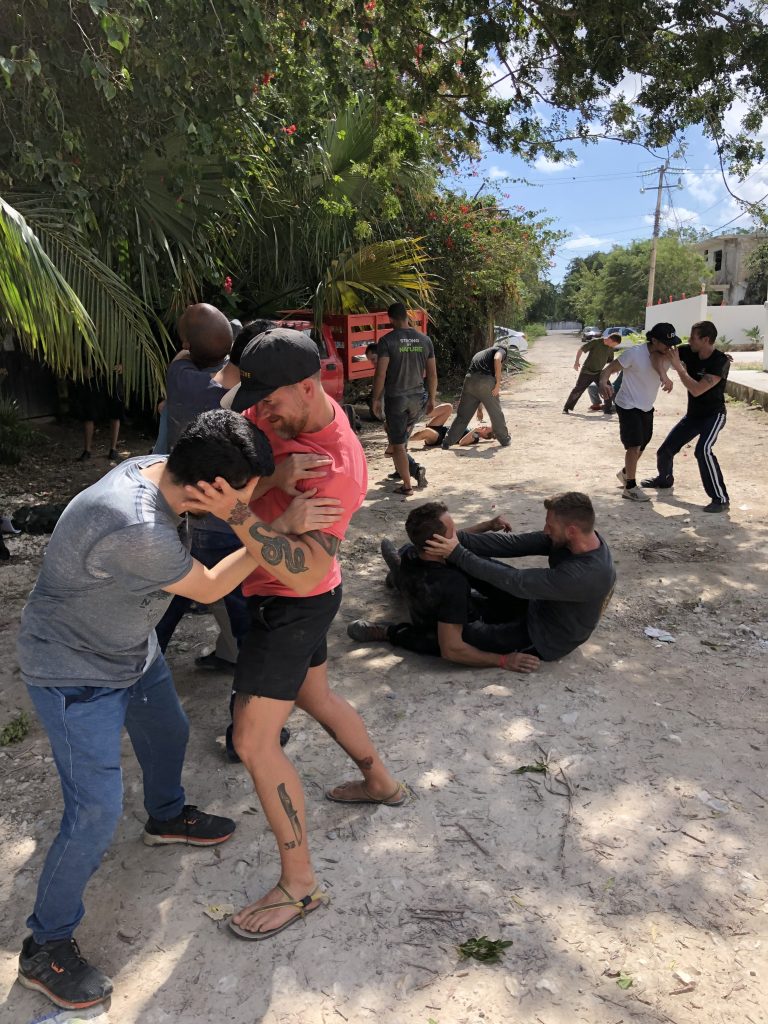
We learned that to fight, you need the proper Mindset, Skills, and Conditioning (in that order). The mindset is most important, followed by skills, and finally conditioning which always helps, and may be necessary depending on the situation.
We learned how to engage the ground safely when violently and unexpectedly pushed from behind, the side, or front. We even played steal the bacon with a knife (rubber training knife) and practiced firearm disarms.
This was definitely a “learn by doing” course with just enough lecture & discussion to provide the participants with a well-earned break.
There were also many progressively more realistic/difficult situations and scenarios to train through, to add elements of adaptability and stress inoculation. In one particular scenario, I was supposed to escape two muggers. I got away the first time, but had to fight for several minutes the second time through.
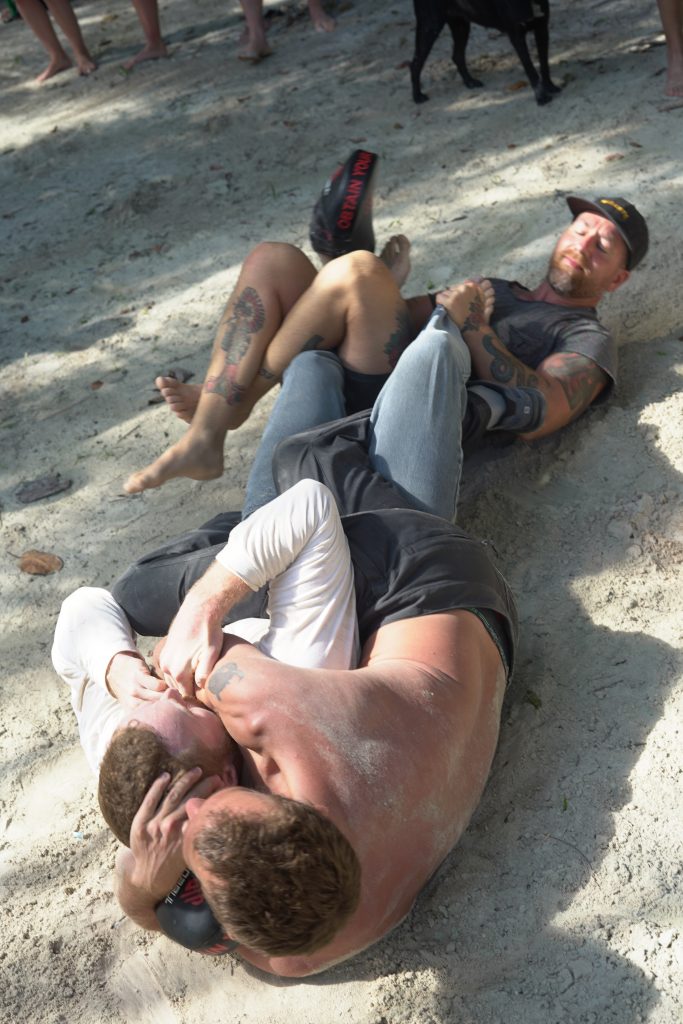
We learned how to punch, stomp, maintain distance, and protect yourself from blunt and edged weapons (and firearms). We learned how to use improvised weapons. And more importantly, we DRILLED all of these things constantly. The value was not only to rehearse them enough to remember for future training, but to get a realistic idea of how prepared you actually are to deal with a certain situation…right here, right now. Your baseline.
If someone is fast approaching you holding a baseball bat and yelling obscenities, and you can’t escape, can you actually engage them? What if it’s an edged weapon or firearm? What if it’s a group? You won’t have any idea what you’ll do or how well you’ll do it until you experience these situations. And even then, there are no guarantees. All the training in the world may not be enough.
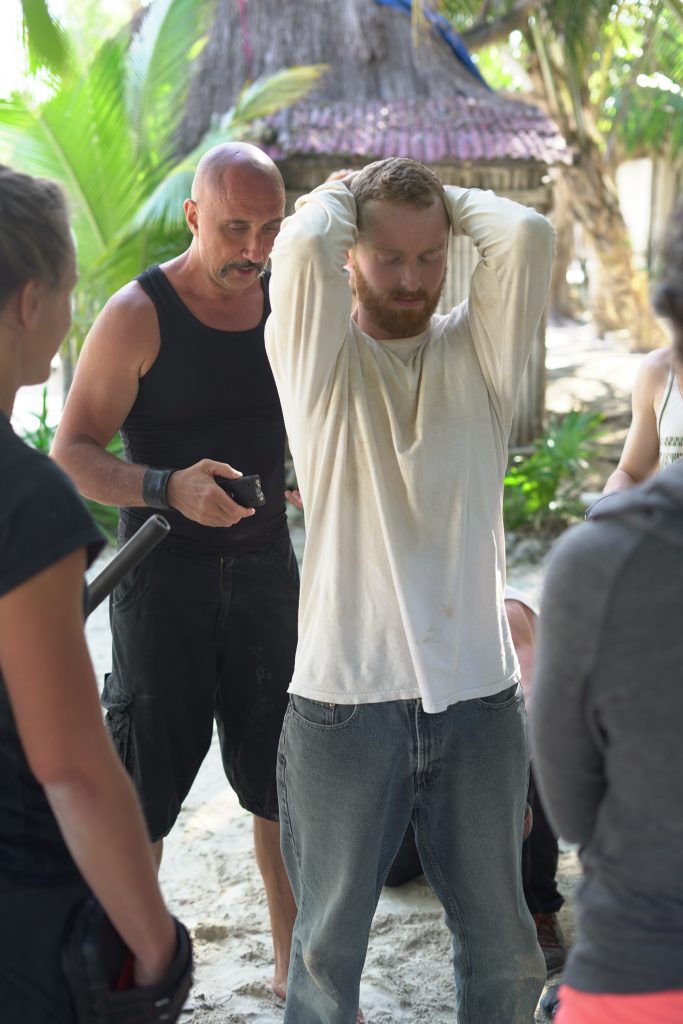
Some people devote a large chunk of their life – their time, energy, and resources – to studying martial arts or training in self defense. They may spend hours a week, even decades of their life, mastering these disciplines that they’ll hopefully never need to use. And ironically, the more they train, the less likely they will be to need defensive skills.
But here’s the kicker: even the most advanced practitioners are subject to the realities of violence. All human beings are fragile – easy to hurt or kill. All human beings can be tricked or surprised, out-maneuvered, or overwhelmed. No one is invincible, and everyone can be victimized. One of our “homework assignments” really drove this point home in a way that none of us will forget. But understanding how violence works, becoming more aware of your surroundings, being able to trust your intuition and gut feelings, practicing some basic but effective techniques, and learning what you’re truly capable of will help immensely.
Needless to say, we covered a lot in two days – practicing every concept we learned in a practical way to solidify the lessons. I took several pages of notes. And this review barely scratches the surface of what was covered in the curriculum.
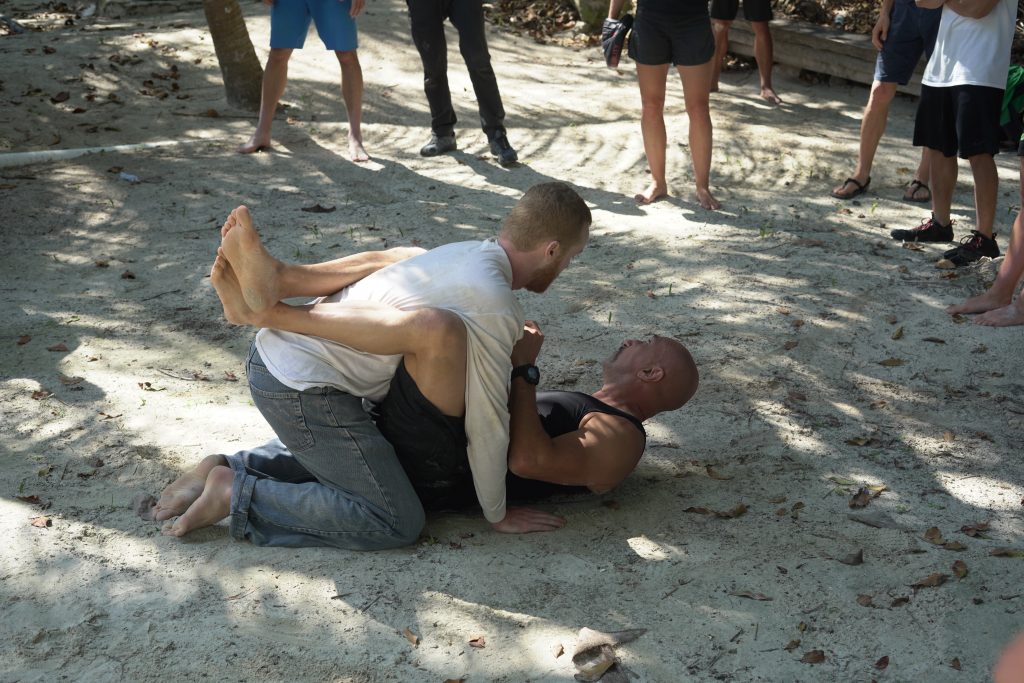
One of the biggest takeaways was how serious violence is, how quickly it can escalate, and how much is at stake when it does occur; and thus, why it’s so important to avoid it if at all possible, and fight with everything you’ve got when you can’t.
While there were dozens of techniques and drills taught, here are a few of the other big picture takeaways:
- Violence has consequences. It always costs something.
- Avoidance skills are more important than defensive skills.
- Anyone can be victimized (even very well-trained practitioners).
- You cannot control how a predator sees you, but you can control how you present yourself.
- Criminals think and act differently than normal people.
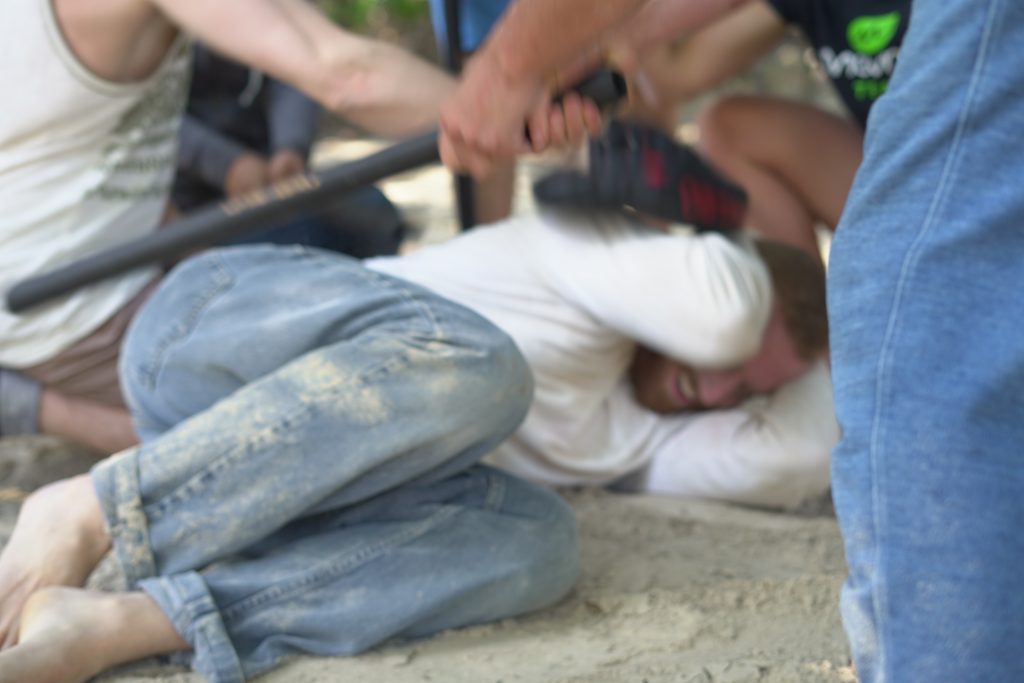
What I really appreciated about this course and about Vic’s instruction, in general, was that it was very honest. He didn’t beat around the bush or try to downplay the reality of violence or instill false confidence. If you’re facing a larger attacker, an armed attacker, a group of attackers, or anyone who uses the element of surprise or deception to victimize you, it’s probably going to be very difficult to deal with it. And you may not survive it.
But despite the fact that we don’t get to choose when or where we are targeted, there is so much we can do to prepare for violence, and this was a perfect crash course for that.
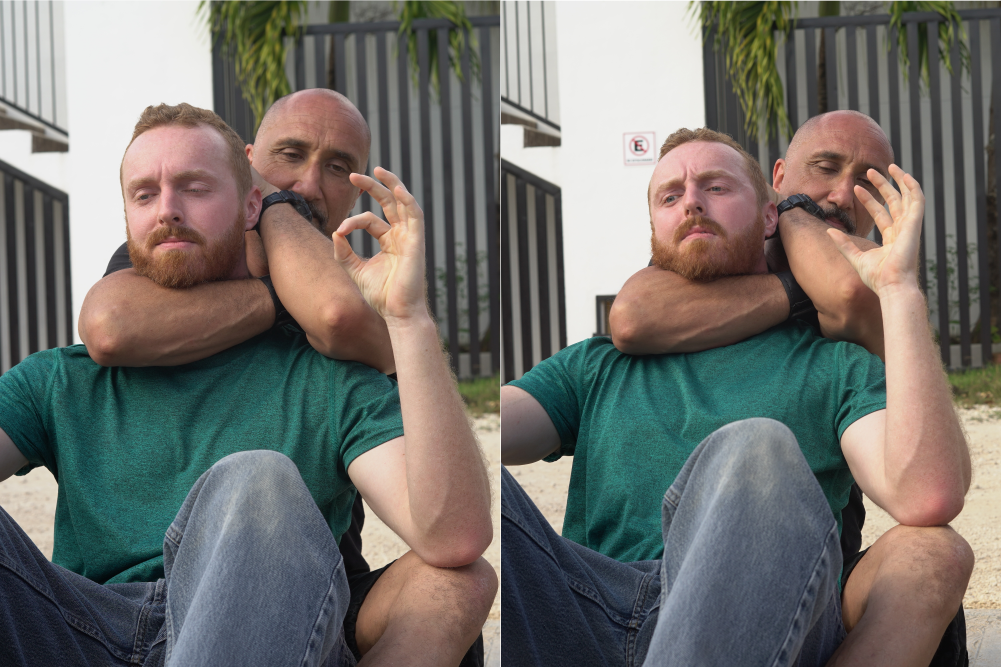
You’re probably wondering, is this course dangerous?
There was risk present all throughout this course. However, safety was strongly emphasized. So, while you may get a little banged up during some of the drills, this is a very safe course. At no time did I ever feel like I was in danger of getting hurt.
Having said that, I did twist my ankle during one of the drills while my sparring partner was taking me down. And I know of a couple other participants who sustained minor injuries. I don’t think realistic self defense training can be practiced without these kinds of risks. So, I don’t see this as a knock on the course itself, but you should be aware that you’ll be practicing vigorously.
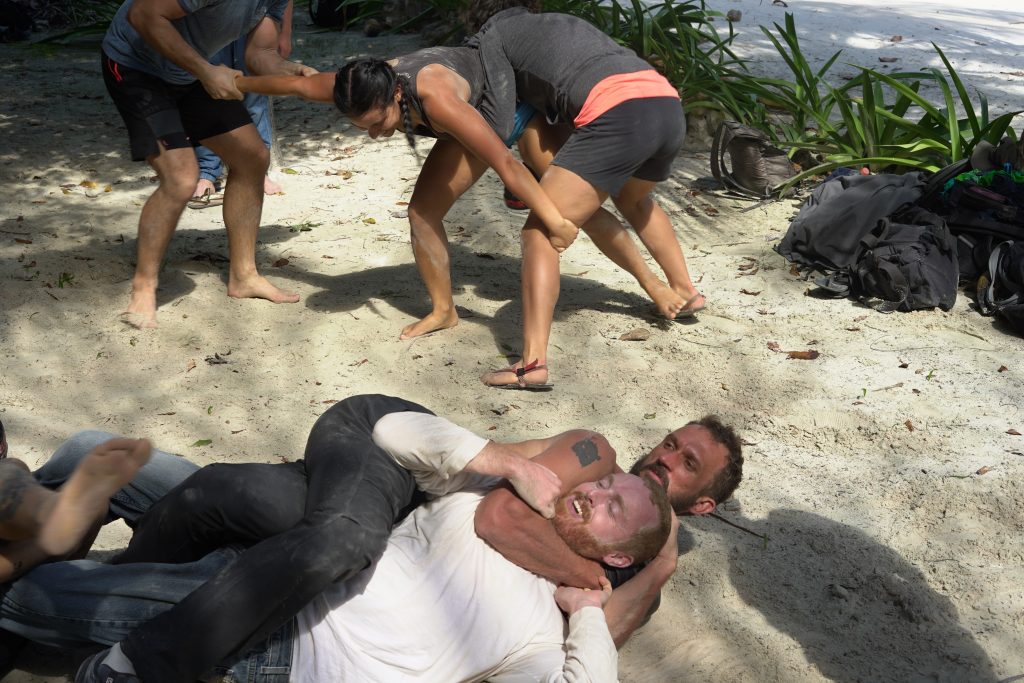
The Pros and Cons
The major advantage of this course is that you’re exposed to so much knowledge and so many drills and skills to develop in a safe, incrementally progressive format. The downside is that there’s only two days to cover everything. Many times, I felt like I was just getting the hang of a drill and we would move on to the next one.
If I were to make one suggestion to Vic, it would be to allow students to mix up their training partners a little more to experience different opponents (e.g. larger, more skilled, etc.).
Before I wrap up, I’d like to thank Vic for providing a top-notch course that was enlightening, challenging, safe, and professional. I’d also like to thank my friends and fellow students for their positive attitudes, and encouragement. Also, to Stefano for going easy on me during one of the drills…and to Damian for not going easy on me.
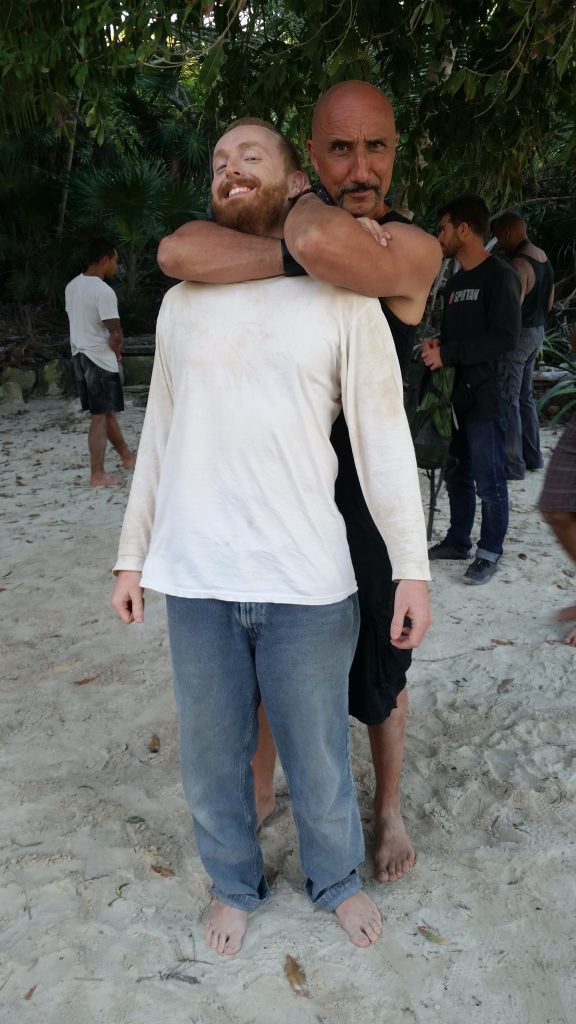
The Bottom Line
Is this the right course for you?
MovNat Combatives was expertly instructed, eminently practical, and a ton of fun. There was zero fluff, and nothing triggered the bull-crap meter. It was raw and real and I think experiencing it will help prepare you for violence – even with only two days of training.
At my course, there were men and women of all experience levels – including several beginners and also some lifelong martial artists of various styles (MMA, BJJ, Wrestling, Ninjutsu, etc.). Some of those students have taken this course multiple times, which speaks to its value. I hope to attend it again soon (maybe this Winter – see below!).
If you want a deep introduction to the realities of violence and how to prepare for them, I don’t think you can do much better than this. You’ll get a well-grounded perspective of your current self defense capabilities and go home with a working knowledge of how to avoid and overcome violence. Not to mention dozens of drills you can practice to improve your skills and conditioning for years to come.
Who is this course best-suited for? Two types of people come to mind: total beginners with zero experience in martial arts or self defense training, and also experienced martial artists and MMA/sport fighters who have never encountered real violence. Or, those who have and realize they still have so much to learn.
Next Steps
Now, if YOU would like to attend a MovNat Combatives workshop, they have upcoming courses in Vienna, Austria (Oct 2019) and Denver, Colorado (Jan 2020). I also heard there’s a 1-day introductory workshop happening in Sayulita, Mexico in early 2020. I’m hoping to attend that one, and you’ll have to contact me if you’d like more information.
CLICK HERE TO LEARN MORE ABOUT MOVNAT COMBATIVES
Use coupon code “john_movnat” to save 10% on these events. And make sure you get on their mailing list for news about future training opportunities.
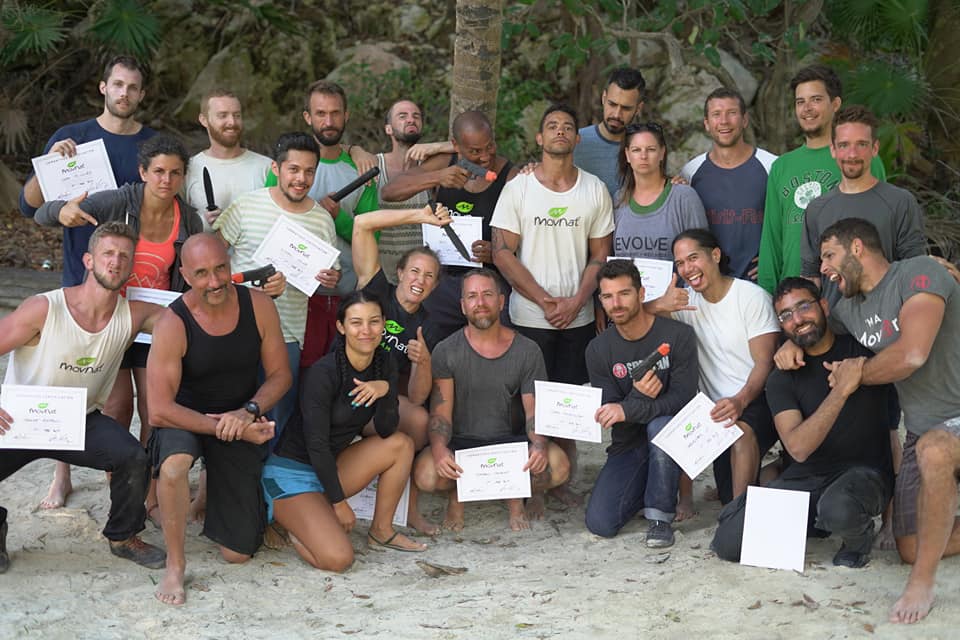
All photos provided courtesy of MovNat.
Related Posts
- MovNat Aquatics: How I Got Comfortable in the Water After a Lifetime of Fearing It
- MovNat Immersion: The Ultimate Natural Movement Challenge (Review)
- MovNat 5-Day Retreat Review
- MovNat Certification Program Review – Levels 1, 2, & 3 (Coming Soon!)
Good review.
Yes. There are still those who check your site.
Your words are always relevant.
Thanks, Norman!
Hi John, This is an incredible review! I took the course in Portland in August and everything you wrote is spot on!
Hi Margot! It’s great to hear from you. Thank you for the kind words. Hope all is well!